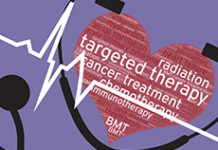In a first randomised study to evaluate the therapeutic strategy of combining stereotactic ablative radiotherapy (SABR) with immunotherapy for patients with newly diagnosed early-stage or recurrent node-negative non-small cell lung cancer (NSCLC), SABR with immunotherapy led to significant improvements in event-free survival (EFS) compared with SABR alone, with EFS rate of 77% versus 53% at 4 years (hazard ratio [HR] 0.38 in the primary study population), corresponding to a 62% reduction in the risk of recurrence, disease progression, or death.
The benefit occured across major subgroups, including cases with PD-L1-negative tumours. The findings are published by Prof. Joe Y Chang of the Department of Radiation Oncology, The University of Texas MD Anderson Cancer Center in Houston, TX, US, and colleagues on 18 July 2023 in The Lancet.
The authors wrote in the background that SABR is the standard treatment for medically inoperable early-stage NSCLC, but regional or distant relapses, or both, are common. SABR has also shown good efficacy in patients with isolated lung parenchymal recurrences. Emerging evidence indicates that radiotherapy and immunotherapy might have synergistic effects. With an aim to reduce recurrence and improve outcomes after SABR for treatment-naive early-stage (node-negative) or isolated parenchymal recurrent NSCLC, and to test the theoretical advantages of combining SABR with immunotherapy, the study team conducted a phase II randomised study of SABR alone versus SABR with immunotherapy.
This open-label, randomised, phase II study was conducted at 3 different hospitals in Texas, US. Patients aged 18 years or older with histologically proven treatment-naive stage IA–IB (tumour size ≤4 cm, N0M0), stage IIA (tumour size ≤5 cm, N0M0), or stage IIB (tumour size >5 cm and ≤7 cm, N0M0) as per the American Joint Committee on Cancer version 8 staging system or isolated parenchymal recurrences (tumour size ≤7 cm) NSCLC (TanyNanyM0 before definitive surgery or chemoradiotherapy) were included in the study.
Patients were randomly assigned 1:1 to receive SABR with or without 4 cycles of nivolumab (480 mg, once every 4 weeks, with the first dose on the same day as, or within 36 hours after, the first SABR fraction). This study was unmasked. The primary endpoint was 4-year EFS (local, regional, or distant recurrence; second primary lung cancer; or death). Analyses were both intention-to-treat (ITT) and per protocol. This study is closed to enrolment.
From 30 June 2017 to 22 March 2022, 156 patients were randomly assigned, and 141 patients received assigned therapy. At a median follow-up of 33 months, SABR with immunotherapy significantly improved 4-year EFS from 53% (95% confidence interval [CI] 42–67%) with SABR to 77% (95% CI 66–91%) with HR 0.38 in per-protocol population (95% CI 0.19–0.75; p = 0.0056) and HR 0.42 in ITT population (95% CI 0.22–0.80; p = 0.0080).
There was no grade 3 or higher adverse events associated with SABR. In SABR with immunotherapy group, 10 patients (15%) had grade 3 immunological adverse events related to nivolumab; none had grade 3 pneumonitis or grade 4 or higher toxicity.
The authors commented that this study adds the highest quality data thus far on immunotherapy in the setting of patients with early-stage NSCLC and those with isolated pulmonary recurrences being treated with SABR. The results of several ongoing phase III studies are anticipated to confirm these findings.
In an accompanied comment, Dr. Eric D Brooks of the Department of Radiation Oncology, University of Florida College of Medicine in Jacksonville, FL, US wrote that the study limitations offer pause, but it adds to the evidence base and offers ongoing lessons about lung cancer antitumour immunity. Substantial study limitations are a moderate sample size, patient population heterogeneity (20% of patients with isolated local recurrence admixed with 80% of patients with de novo stage I–IIB disease, diverse histologies and broad-ranging tumour sizes, including 1-6% of patients with multiple lesions), sparse routine PD-L1 testing for correlative analysis and a short follow-up of only 33 months. Long-term results of this study and the completion of the phase III randomised clinical trials are required before making final conclusions.
The study was funded by Bristol-Myers Squibb and MD Anderson Cancer Center Alliance, National Cancer Institute at the US National Institutes of Health through Cancer Center Core Support Grant and Clinical and Translational Science Award to The University of Texas MD Anderson Cancer Center.






